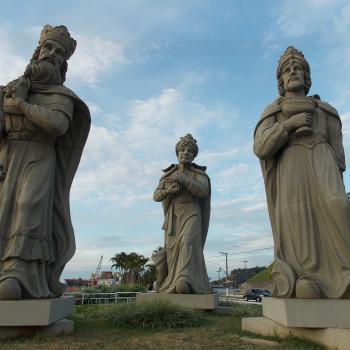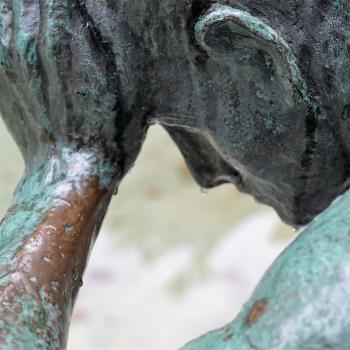Last week we addressed Augustine’s “psychological model” of the Trinitarian image: memory, knowledge, and will. Maybe that worked for you; maybe it didn’t. But Augustine had another model that you might find more compelling. It’s called a “social model” of the Trinity, and it begins and spins in love.
When Augustine begins his quest for understanding the Trinity, he looks at the imago dei echo in our own lives. Thus, the operations of memory, knowledge, and will. But that isn’t the only place there’s a very deep and unique resonance between the nature of God and its imprint on our lives.
“God is love,” John tells us (1 Jn. 4.8). Hmm. God is love. What a bold and provocative statement. Not: God is loving, or God loves, or God prioritizes love. True as all those are, they are inadequate to the statement that God is love. If, Augustine reasons, God is love, then our experiences of love must give us some clues about the nature of the Trinity. Somehow we should be able to dig into love on the human level and there find a mother lode of truth that can lead us into the heart of God.
So, what does Augustine find when he digs?
He finds that love essentially requires a relationship. Love is not love unless there is someone who loves and someone who is loved, a subject and an object. Love does not exist in a vacuum. There is no such thing as generic “love.” If God is Love itself, then we can conclude that God is relational—not virtually, as in, God relates to us, to his creation—but intrinsically. Apart from us, before we existed, before all that is was created, God was Love even then.
Augustine then begins to understand that the nature of God reveals a Lover and a Beloved. And, because the extension of Love between the two is divine, that Love itself is personal, distinct, shared, named—Spirit. Lover, Beloved, Love. Love given, Love received, Love exchanged. The Three moving as in a dance, ever-giving, ever-receiving Love between them: “They are each in each and all in each and each in all and all in all and all are one.” Anatalios calls this “mutual inseparability.”
We would be wrong, however, to think we can simply measure or understand this Inner Divine Love by our own experiences of love, no matter how deep or genuine they may be. Yes, we love, and we exchange love, and this itself is a sign of the Divine Love. But the operative word here is “sign.” If we cling to our own versions of love and believe they are sufficient for knowing God, we will fall far short. Instead, we must look at them as indicators or markers of something much greater.
Just as Augustine tells us that our memory, knowledge, and will only become avenues of knowing God when they are directed toward him, so human love must plunge us into a far greater relationship: that of loving God and being loved by him.
This, then, is what prevents us from swallowing whole all the insipid blather about love that we hear touted in music, media, and movies. All love is not created equal; much of what the world calls love is deeply selfish, consuming, and cruel. John himself, calling God Love, tells us what True Love is: “God’s love was revealed among us in this way: God sent his only Son into the world so that we might live through him” (1 Jn. 4.10). This is True Love: human salvation through divine sacrifice. This is True Love: Emmanuel (Mt. 1.23). This is True Love: Christ and the Life he gives (Jn. 3.16).
This is how Anatolios describes it: “The authentic knowing of God cannot happen by humanity’s projecting its own material or even spiritual experience onto God. . . . The way to true knowledge of God is that provided by God himself [and] the supreme such sign and sacrament is Jesus Christ.”
When human love displays some of these components—self-sacrifice, commitment without limits, pursuing fullness of good for another—then we can begin to hear the echoes. And yes, this kind of love is passionate and personal and intimate; and it’s heartbreaking and full of suffering and urgent and enduring.
Even The Princess Bride in all its glorious silliness can speak of True Love.
“Do you love me, Westley? Is that it?”
He couldn’t believe it. “Do I love you? My God, if your love were a grain of sand, mine would be a universe of beaches! If your love were—”
“I don’t understand that first one yet,” Buttercup interrupted. She was starting to get very excited now. “Let me get this straight. Are you saying my love is a grain of sand and yours is this other thing? Images confuse me so—is this universal business of yours bigger than my sand? Help me, Westley. I have the feeling we’re on the verge of something just terribly important.”
So, from echoes like these, where do we turn to find their source? These signs of True Love find their purpose and fulfillment when we let them compel us to Christ. There—in loving him and being loved by him—we find the original vibrations of the imago dei. “The life I now live in the flesh I live by faith in the Son of God who loved me and gave himself for me” (Gal. 2.20). And, Augustine suggests, that living-believing-loving-exchanging movement is the current of the Holy Spirit, the “giveable God.”
“Augustine conceives of the Spirit as both Love and Gift within the divine being, the mutual love of the Father and the Son, which eternally proceeds so as to be the donability of God.” (Anatolios) Being filled with the Spirit, then, is being filled with the Love of God. We often remember our duty to love God with all our heart, soul, mind, and strength—as we should—but we forget that we cannot love him until we have allowed that True Love to fully love us, to fill us and enable us to love.
“We love because he first loved us . . . By this we know that we live in God and God in us, because he has given us of his Spirit . . . So we have known and believe the love that God has for us” (1 Jn. 4.10, 13, 19).Thus the Trinity moves: internally as Lover, Beloved, Love; externally as a summons to full relationship with the Father through loving and being loved by the Son on the current of the Holy Spirit. Anatolios: “In the economy of salvation, Jesus gives us the Spirit and the Spirit gives us Jesus as Lord and we are thus enfolded into the circle of mutual Trinitarian glorification.”
But let’s give Julian the last word today, too, because she is ravished by the love of God:
And after this our Lord showed himself more glorious in my sight than I had ever seen him before. In this I was taught that our soul shall never have rest until it comes to him, knowing that he is the fullness of joy, familiarly and courteously blissful, and life itself.
Our Lord Jesus frequently said, “I am it! I am the one! I am that which is the highest! I am what you love! I am what delights you! I am the one you serve! I am what you long for! I am what you desire! I am what you intend! I am all! (chap 26).
We’ve nearly finished Anatolios’ book! (Are you weary of the topic?) In wrapping up, we’ll explore some of his summary remarks on incorporating Nicene spirituality into contemporary Christian faith and practice.
___________________________
Note to Reader: This series on Trinitarian Spirituality explores the history and spirituality behind the shaping of the Nicene Creed using Khaled Anatolios’ Retrieving Nicaea: The Development and Meaning of Trinitarian Doctrine (Grand Rapids, MI: Baker Academic, 2011) as guide and inspiration. It’s best to begin at the beginning: An Introduction.













